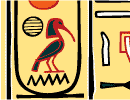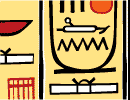by
Nicholas Reeves
"Slowly, desperately slowly it seemed to us as we watched, the remains
of the passage debris that encumbered the lower part of the doorway were
removed, until at last we had the whole door clear before us. The decisive
moment had arrived."
- [The Tomb of Tut.ankh.Amen, vol. I, by Howard Carter and Arthur C.
Mace (London, 1923), pp. 95-96]
On November 4, 1922, Howard Carter and his sponsor, the fifth Earl of
Carnarvon, made a discovery in Egypt's Valley of the Kings that would
change the face of archaeology forever. The two Englishmen had, for the
first time in recorded history, stumbled upon the tomb of an Egyptian
pharaoh — the boy-king Tutankhamun, son and successor of the heretic
Akhenaten. The grave was piled high with magnificent treasures and gold.
The popular perception of Egyptology changed overnight. No longer the
province of dusty academics, it was now seen as high-stakes adventure.
Without the excitement of Tutankhamun, Indiana Jones would never have been
born.
"With trembling hands I made a tiny breach in the upper left-hand
corner. Darkness, and blank space, as far as the iron testing-rod could
reach, showed that whatever lay beyond was empty, and not filled like the
passage we had just cleared. Candle tests were applied as a precaution
against possible foul gases, and then widening the hole a little, I
inserted the candle and peered in."
The story of the find reads like a fairy tale: Carter dug fruitlessly
for years in pursuit of an impossible dream. Then, in his final season, he
found the tomb he had been seeking for so long. The discovery's impact
exploded around the world and turned its discoverers into celebrities
overnight. But with the unexpected death of Lord Carnarvon — the supposed
victim of an apocryphal "pharaoh's curse" — the triumph turned sour.
Against a background of jealousy, greed and nascent revolution, the
situation in Egypt spiraled downward, out of control. It would result in
an end to the generous, 50-50 division of artifacts upon which
archaeological work in Egypt had for long years been based.
"At first I could see nothing, the hot air escaping from the chamber
causing the candle to flicker, but presently, as my eyes grew accustomed
to the light, details of the room within emerged slowly from the mist:
strange animals, statues, and gold — everywhere the glint of gold."
Later research showed Tutankhamun died unexpectedly in 1323 B.C.,
probably from a blow to the head and perhaps at the hands of an assassin.
His burial, within a small, adapted private tomb, had been hastily
assembled by his successor, the "god's father" Ay, who did the boy proud.
Three of the tomb's four chambers were laden with ritual paraphernalia
intended to see Tutankhamun safely into the next life.
Only gradually did it sink in that these rooms had actually been
plundered in antiquity, on two separate occasions, by grave robbers. But
in the fourth chamber, within a series of four huge, gilded shrines, a
beautiful quartz-and-sandstone sarcophagus, and a nest of three
magnificent coffins (the innermost of solid gold), lay the royal mummy
itself. Eaten away by the very unguents intended to foil the corruption of
time, the body was crowned by a sublime gold portrait mask and smothered
with layer upon layer of precious jewelry and amulets.
"For the moment — an eternity it must have seemed to the others
standing by — I was struck dumb with amazement."
Despite his riches, Tutankhamun had in life been a relatively
insignificant king, too young to impose his personality on his kingdom and
forgotten by those who came after. But Tutankhamun became, 3,000 years
after his death, the most famous of the pharaohs. He stands as an icon not
only of Egyptology, but of archaeology itself.
"When Lord Carnarvon, unable to stand the suspense any longer, inquired
anxiously, 'Can you see anything?' it was all I could do to get out the
words: 'Yes, wonderful things.'"
NICHOLAS REEVES, Director of the Amarna Royal Tombs Project, Valley of
the Kings, continues digging where Carter left off. He is an Honorary
Fellow at the Oriental Museum, University of Durham, and Honorary Research
Fellow at the Institute of Archaeology, University College London. He has
written extensively on Tutankhamun.





